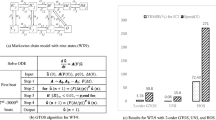Abstract
The Markovian model has generally been used for cardiac electrophysiological simulations. However, the Markovian model is so stiff that speeding up the computation of the algorithms with variable time-steps always results in simulation instability. In particular, the unstable simulations always occur at a low voltage rate or current change, while transition rates in the Markovian model are changing markedly. The uniformization (UNI) method allows for a Markovian model simulation with high stability but also a high computation cost. To save computation costs with variable time-steps, we propose a speed increasing idea that is a compromise to the trade-off between stability and acceleration by combining Chen-Chen-Luo’s “quadratic adaptive algorithm” (CCL) method with “hybrid operator splitting” (HOS) into the solver (CCL + HOS solver). The computation cost of this CCL + HOS solver is approximately 24 times lower than the CCL + UNI solver, and the CCL + HOS solver can function 295 times faster in comparison to the HOS solver with a fixed time-step (DT). The suggested optimal solver should be CCL + HOS solver with a maximum time-step at 0.1 ms due to its high speed with low error. Additionally, the CCL method has much better performance and stability than the hybrid method in this single-cell model simulation.







Similar content being viewed by others
References
Clancy CE, Rudy Y (1999) Linking a genetic defect to its cellular phenotype in a cardiac arrhythmia. Nature 400:566, 569
Bankston JR, Sampson KJ, Kateriya S, Glaaser IW, Malito DL, Chung WK, Kass RS (2007) A novel LQT-3 mutation disrupts an inactivation gate complex with distinct rate-dependent phenotypic consequences. Channels 1:273–280
Greer-Short A, George SA, Poelzing S, Weinberg SH (2017) Revealing the concealed nature of long-QT type 3 syndrome. Circ Arrhythm Electrophysiol 10:e004400
Campana C, Gando I, Tan RB, Cecchin F, Coetzee WA, Sobie EA (2018) Population-based mathematical modeling to deduce disease-causing cardiac Na + channel gating defects. Biophys J 114:634a–635a
Moreno JD, Lewis TJ, Clancy CE (2016) Parameterization for in-silico modeling of ion channel interactions with drugs. PLoS One 11:e0150761
Spiteri RJ, Dean RC (2010) Stiffness analysis of cardiac electrophysiological models. Ann Biomed Eng 38:3592, 3604
Reibman A, Trivedi K (1988) Numerical transient analysis of Markov models. Comput Oper Res 15:19–36
Gomes JM, Alvarenga A, Campos RS, Rocha BM, da Silva APC, dos Santos RW (2015) Uniformization method for solving cardiac electrophysiology models based on the Markov-chain formulation. IEEE Trans Biomed Eng 62:600–608
Starý T, Biktashev VN (2015) Exponential integrators for a Markov chain model of the fast sodium channel of cardiomyocytes. IEEE Trans Biomed Eng 62:1070–1076
Victorri B, Vinet A, Roberge FA, Drouhard J-P (1985) Numerical integration in the reconstruction of cardiac action potentials using Hodgkin-Huxley-type models. Comput Biomed Res 18:10–23
Luo CH, Rudy Y (1991) A model of the ventricular cardiac action potential. Depolarization, repolarization, and their interaction. Circ Res 68:1501–1526
Chen MH, Chen PY, Luo CH (2016) Quadratic adaptive algorithm for solving cardiac action potential models. Comput Biol Med 77:261–273
Clancy CE, Rudy Y (2002) Na+ channel mutation that causes both Brugada and long-QT syndrome phenotypes. Circulation 105:1208–1213
Luo CH, Rudy Y (1994) A dynamic model of the cardiac ventricular action potential. I. Simulations of ionic currents and concentration changes. Circ Res 74:1071–1096
Sidje RB, Burrage K, MacNamara S (2007) Inexact uniformization method for computing transient distributions of Markov chains. SIAM J Sci Comput 29:2562–2580
Rudy Y, Silva JR (2006) Computational biology in the study of cardiac ion channels and cell electrophysiology. Q Rev Biophys 39:57–116
Hille B (2001) Ion channels of excitable membranes, vol 507. Sinauer, Sunderland, MA
Marsh ME, Ziaratgahi ST, Spiteri RJ (2012) The secrets to the success of the Rush-Larsen method and its generalizations. IEEE Trans Biomed Eng 59:2506–2515
Van Moorsel AP, Sanders WH (1997) Transient solution of Markov models by combining adaptive and standard uniformization. IEEE Trans Reliab 46:430–440
Qu Z, Garfinkel A (1999) An advanced algorithm for solving partial differential equation in cardiac conduction. IEEE Trans Biomed Eng 46:1166
Krishnamoorthi S, Sarkar M, Klug WS (2013) Numerical quadrature and operator splitting in finite element methods for cardiac electrophysiology. Int J Numer Method Biomed Eng 29:1243–1266
Torabi Ziaratgahi S, Marsh ME, Sundnes J, Spiteri RJ (2014) Stable time integration suppresses unphysical oscillations in the bidomain model. Front Phys 2:40
Starý T, Biktashev VN (2015) Evaluating exponential integrators for Markov chain ion channel models. In: Computing in Cardiology Conference, 2015. pp 885–888
Moreno JD, Yang PC, Bankston JR, Grandi E, Bers DM, Kass RS, Clancy CE (2013) Ranolazine for congenital and acquired late INa-linked arrhythmias: in silico pharmacological screening. Circ Res 113:E50–E61
Funding
This work was supported by Sun Yat-sen University, China, under Scientific Initiation Project (No.67000-18821109) for High-level Experts. M.-H. Chen was supported by the Ministry of Science and Technology of Taiwan under grant 106-2115-M-006-010-.
Author information
Authors and Affiliations
Corresponding author
Ethics declarations
Conflict of interest
The authors declare that they have no conflict of interest.
Additional information
Publisher’s note
Springer Nature remains neutral with regard to jurisdictional claims in published maps and institutional affiliations.
Rights and permissions
About this article
Cite this article
Chen, XJ., Luo, CH., Chen, MH. et al. Combination of “quadratic adaptive algorithm” and “hybrid operator splitting” or uniformization algorithms for stability against acceleration in the Markov model of sodium ion channels in the ventricular cell model. Med Biol Eng Comput 57, 1367–1379 (2019). https://doi.org/10.1007/s11517-019-01956-5
Received:
Accepted:
Published:
Issue Date:
DOI: https://doi.org/10.1007/s11517-019-01956-5




